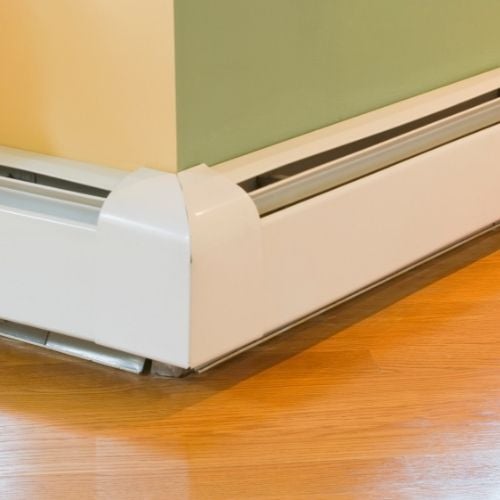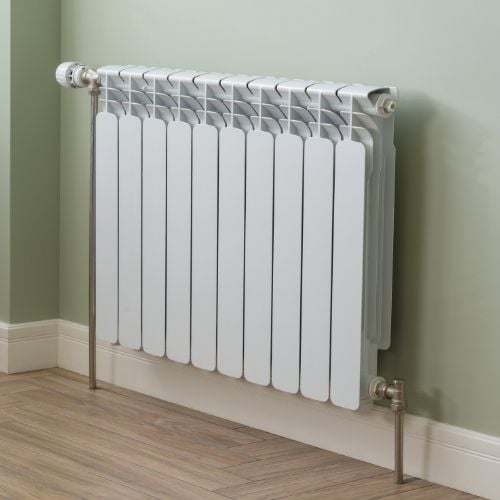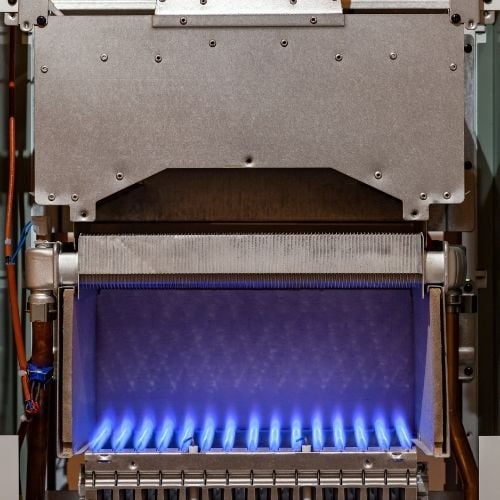What might be common sense to some is understandably unknown to others. Not all people come across the same information in their life. So, if you're a homeowner and you don't know whether your furnace is gas or electric, don't feel bad! It's totally normal to have gone years without hearing anything about this information. It also doesn't help that sometimes people give the wrong information!
If you're one of those people just now figuring out how to tell a gas furnace from an electric one, we're here for you. We're breaking down everything you need to know about furnaces.
Types of heating systems
There are three different types of heating you might find in a building. These days, most homes and apartments have forced air heating. In these systems, a central furnace unit works to warm up air. The system then forces warm air through the duct system and out of the vents into each room. You can recognize a forced air heating system by the vents, usually on the ceiling. Forced air systems may use either gas or electricity to heat the air in the furnace.

Another less common type of heating is baseboard heating. Baseboard heating is easy to spot visually since the heat is distributed via a long, low unit that runs along the baseboards of a room. These units are either electric or hydronic. With the hydronic baseboard heating, a boiler system pumps hot water into the units to heat the room. An electronic system uses electricity to heat the boards and the room they're in.

Radiator heating systems are less common and use a boiler system to heat a home. This is an old-fashioned method, so you'll only find it in old houses and buildings. With this method, each room has steel, aluminum, or cast-iron radiators. The boiler system boils water and creates steam that gets distributed to each of the radiators.
Forced air heating: gas vs electric
One thing that all types of heating systems have in common is the thermostat. The thermostat is the starting point for all the action. When you tell a thermostat to make a room warmer, it sends a signal to whatever unit creates the heat. In the case of a forced air system, it's the furnace. One the furnace knows it needs to make heat; it gets to work.

If it's a gas-powered furnace, it starts with gas-powered burners, which light the gas jets and begin creating heat in a combustion chamber. That heat moves to a heat exchanger, a device that moves heat from one place to another. From there, the warm air moves through the ducts with a little help from some blower fans.
Much of this process is not all that different with an electric furnace. The warm air still gets distributed through the vents via a set of blower fans. What's different is how the air is heated. In an electric furnace, the air is heated by sets of electric coils, or heating elements. It works similarly to a hair drier. The electric coils heat up, the heat exchanger pulls the air through to warm it up, and a fan disperses the hot air.
Distinguishing gas heat from electric heat
Even if you've gone this long without knowing, knowing how to tell gas from electric heat is important. With this knowledge, you can provide the right maintenance and care for your HVAC systems moving forward.
To start making the big discovery, head to the thermostat. Turn on the heat if it's not on already and turn up the temperature. You want to get your HVAC system running strong so that you can check out the furnace while it's on.
.jpg?width=500&name=gas%20or%20electric%20furnace_gas_the%20geiler%20company%20(1).jpg)
Once the heat is blowing through the vents, head to your heating system. In many homes, the furnace is in the basement. Smaller spaces, like apartments, might store the heating system in a closet or nook. Some upstairs apartments might even have it in an attic. If you're not sure where it is, just look around, or follow the duct system. You're looking for a large unit with several metal ducts going into it.
When you've found the unit, you should be able to tell whether it's gas or electric just by looking at it. Remember, a gas furnace uses a flame to start the heating process. If your HVAC unit is gas, you'll be able to see a small flame through a small window on the furnace. These windows are only on gas furnaces. You might also be able to hear the furnace ignite when it turns on or hear the gas burner when it's idle.
If any of the above signs are present, you'll know that you have a gas furnace. Electric furnaces have no window, no flame, and won't make any noise while they're idling.
Other ways to tell
If you can't find your furnace or cannot access it for some reason, there are a few other ways to tell what kind of heating you have.
One way is to look for an exhaust flue. This is a small, chimney-like structure somewhere on your roof. The flue serves as an exit vent for the exhaust gases produced by a gas furnace. Its design is simple and easy to spot. Look for a piece of pipework sticking out from your roof, with a rain cap on top. If you can find one of those, that's an indication that your furnace is gas powered.
If you've made it to the furnace but you're still not certain, look for a label. The furnace may tell you directly whether the furnace is gas or electric. If not, it will give you the name and model of the furnace. You can take that information and look up details about the furnace — not just whether it's gas or electric, but how to care for it better in the long run.
Still have questions? Call or text us at 513-574-0025.
Learn more by visiting our HVAC page.


